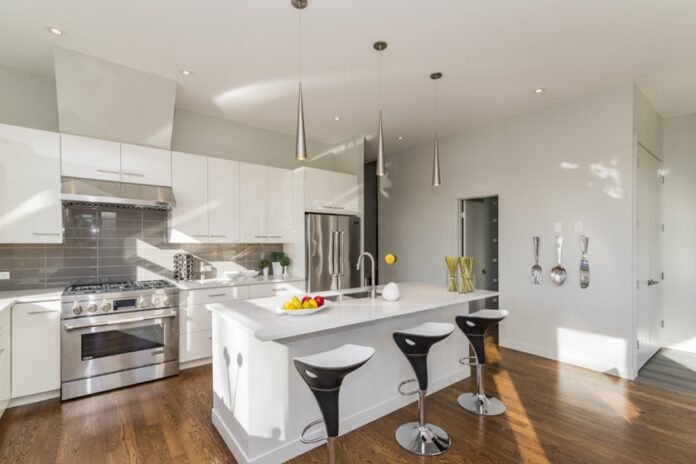Lighting plays a crucial role in kitchen design, influencing both the functionality and ambience of the space. When planning a kitchen renovation, selecting the right lighting can transform your kitchen into a bright, welcoming, and efficient environment. If you’re working with kitchen designers in Perth, here are some essential tips to help you choose the perfect lighting for your kitchen renovation.
1. Understand the Types of Kitchen Lighting
There are three primary types of lighting to consider for your kitchen: ambient, task, and accent lighting. Each type serves a distinct purpose and contributes to the overall effectiveness of your lighting plan.
- Ambient Lighting: This is the general lighting that illuminates the entire kitchen. It often comes from ceiling fixtures, recessed lights, or a combination of both. Ambient lighting provides a comfortable level of brightness and ensures the space is well-lit.
- Task Lighting: Task lighting is focused on specific areas where detailed activities take place, such as food preparation, cooking, and cleaning. Under-cabinet lights, pendant lights over islands, and directional spotlights are common sources of task lighting. It reduces shadows and provides adequate illumination for these activities.
- Accent Lighting: Accent lighting is used to highlight architectural features, décor, or specific areas of interest in your kitchen. It adds depth and dimension to the space. Examples include LED strip lights under cabinets, above-cabinet lighting, or spotlights to showcase artwork or a backsplash.
2. Layer Your Lighting
A well-designed kitchen lighting plan uses a combination of ambient, task, and accent lighting. Layering these types of lighting ensures that your kitchen is functional and aesthetically pleasing. Begin with ambient lighting to provide overall illumination, then add task lighting to brighten work areas, and finish with accent lighting to create visual interest and highlight features.
3. Choose the Right Fixtures
Selecting the right fixtures is essential for achieving your desired lighting effect. Consider the following options:
- Pendant Lights: Pendant lights are perfect for islands, breakfast bars, and dining areas. They provide focused lighting and can serve as a decorative element in your kitchen. Choose pendant lights that complement your kitchen’s style and provide adequate light for the space.
- Recessed Lighting: Recessed lights, also known as downlights, are installed into the ceiling and provide a sleek, unobtrusive lighting solution. They are ideal for ambient lighting and can be strategically placed to illuminate the entire kitchen evenly.
- Under-Cabinet Lighting: This type of task lighting is installed beneath upper cabinets to illuminate countertops and workspaces. It reduces shadows and makes food preparation safer and more efficient. LED strip lights or puck lights are popular choices for under-cabinet lighting.
- Chandeliers: Chandeliers add a touch of elegance and are often used as a focal point in dining areas or larger kitchens. Ensure the size and style of the chandelier fit the overall design of your kitchen.
4. Consider Lighting Controls
Modern lighting controls allow you to adjust the brightness and mood of your kitchen easily. Dimmers, timers, and smart lighting systems can enhance the flexibility and functionality of your lighting plan. Dimmers are particularly useful as they enable you to change the intensity of the light, creating a soft, relaxed atmosphere for dining or brighter illumination for cooking.
5. Choose Energy-Efficient Options
Energy efficiency is an important consideration when selecting kitchen lighting. LED lights are an excellent choice as they consume less energy, have a longer lifespan, and produce less heat compared to traditional incandescent bulbs. Many LED fixtures are also available in a range of colour temperatures, allowing you to customise the lighting to your preference.
6. Work with Professional Kitchen Designers
Collaborating with professional kitchen designers in Perth can make a significant difference in the success of your kitchen renovation. Experienced designers can help you develop a comprehensive lighting plan that incorporates the latest trends and technologies while ensuring the lighting meets your functional and aesthetic needs. They can also assist in selecting the best fixtures and ensuring proper installation.
7. Focus on Natural Light
Maximising natural light can significantly enhance the look and feel of your kitchen. Large windows, skylights, and glass doors can flood your kitchen with daylight, reducing the need for artificial lighting during the day. Consider the orientation of your kitchen and how natural light can be optimised in your design.
8. Balance Aesthetics and Functionality
While the appearance of your lighting fixtures is important, functionality should never be compromised. Ensure that your lighting choices provide adequate illumination for all kitchen tasks and contribute to a safe and efficient working environment.
Conclusion
Choosing the right lighting for your kitchen renovation involves understanding the different types of lighting, layering them effectively, selecting appropriate fixtures, and considering lighting controls and energy efficiency. Working with professional kitchen designers in Perth can help you create a well-lit, functional, and beautiful kitchen. By carefully planning your lighting, you can transform your kitchen into a space that is both practical and inviting, enhancing your cooking and dining experience.















